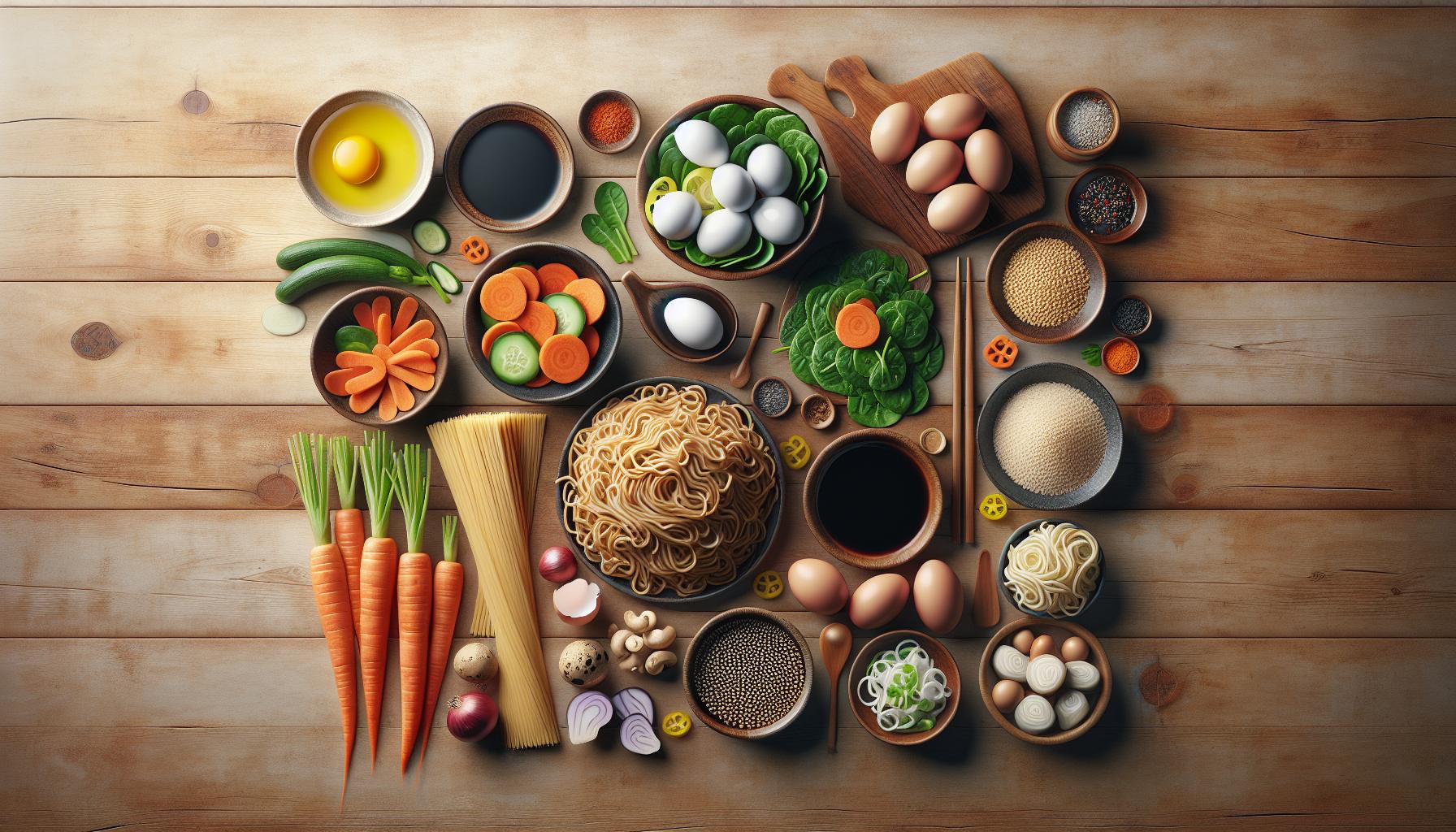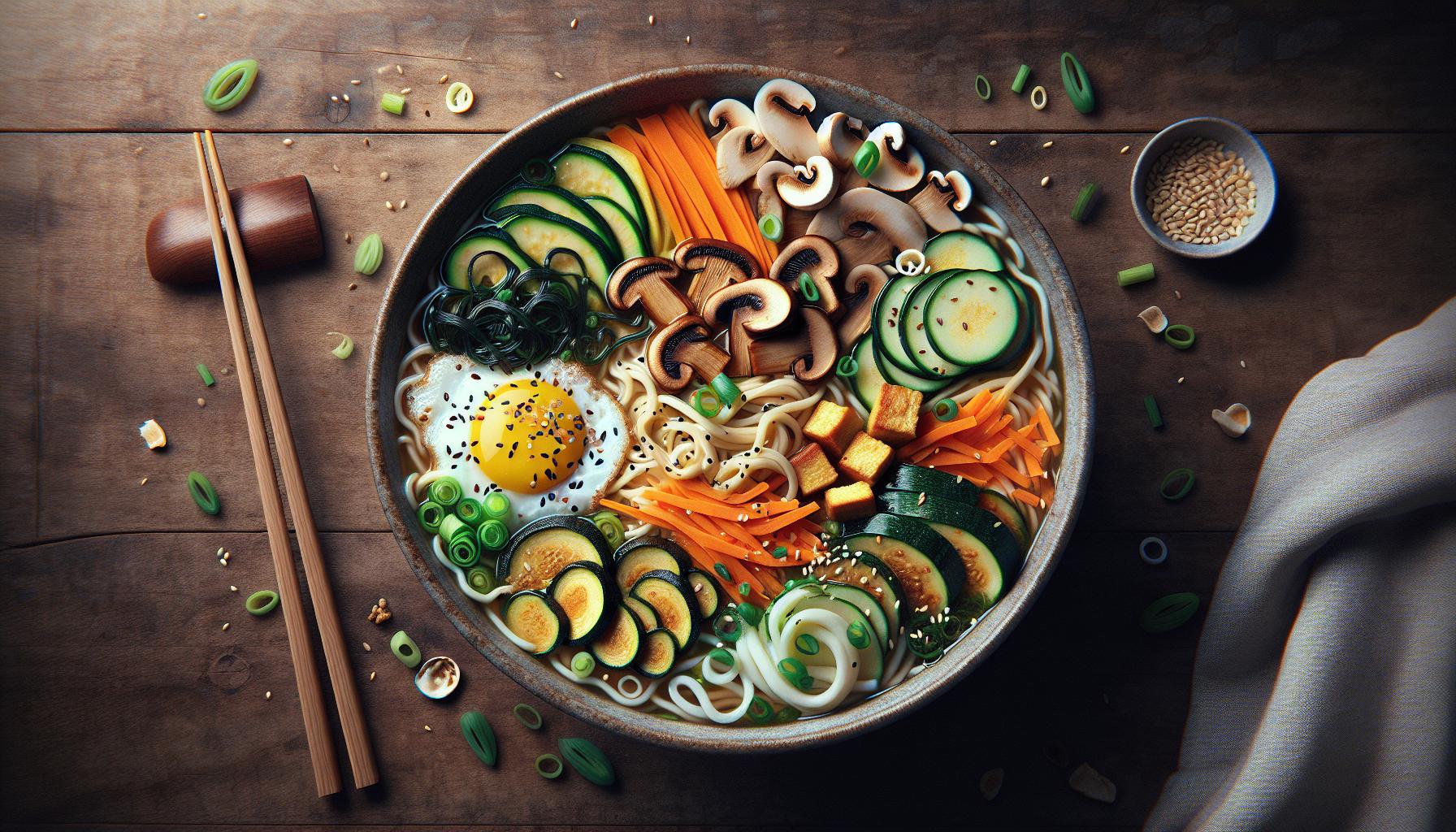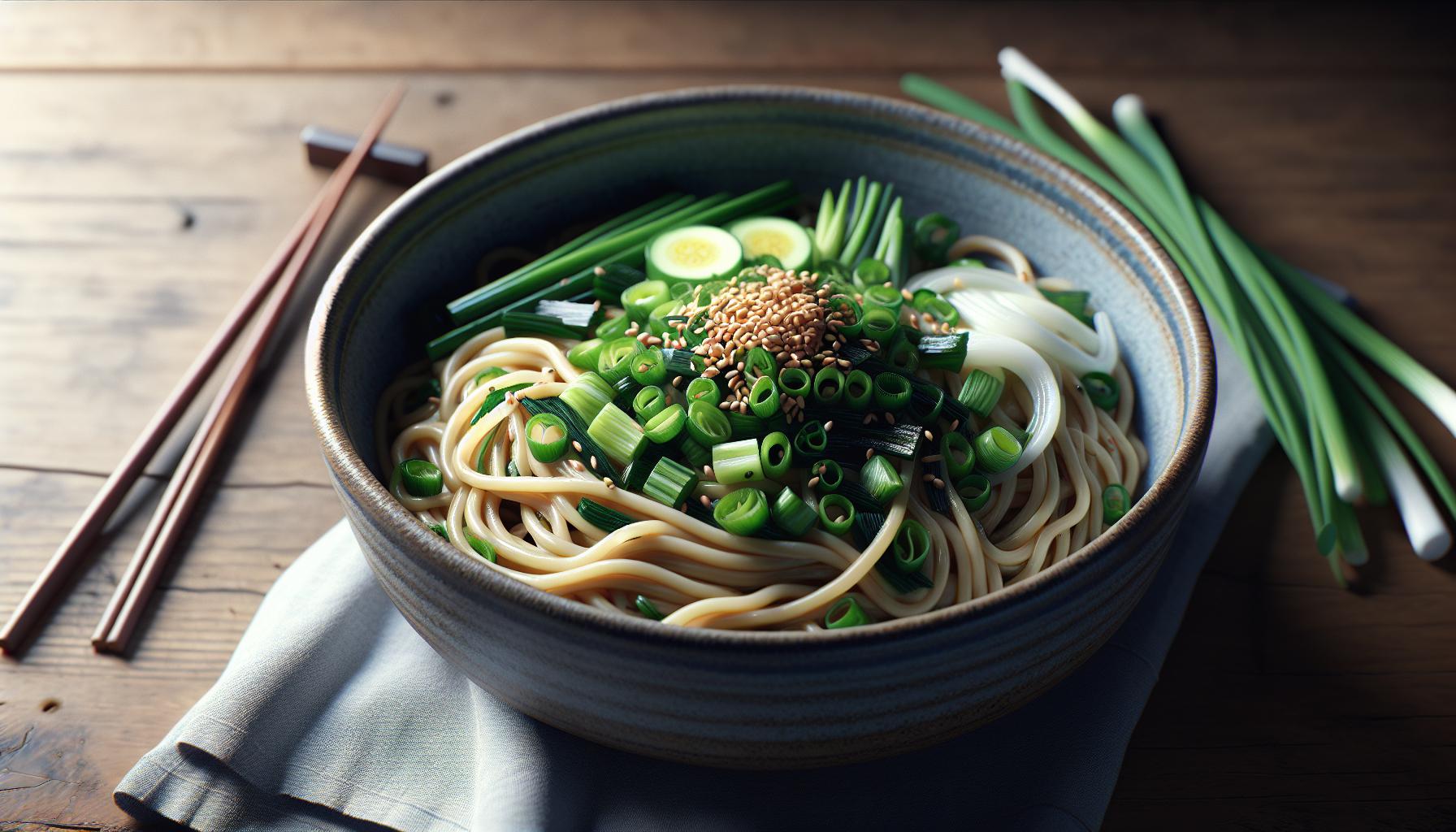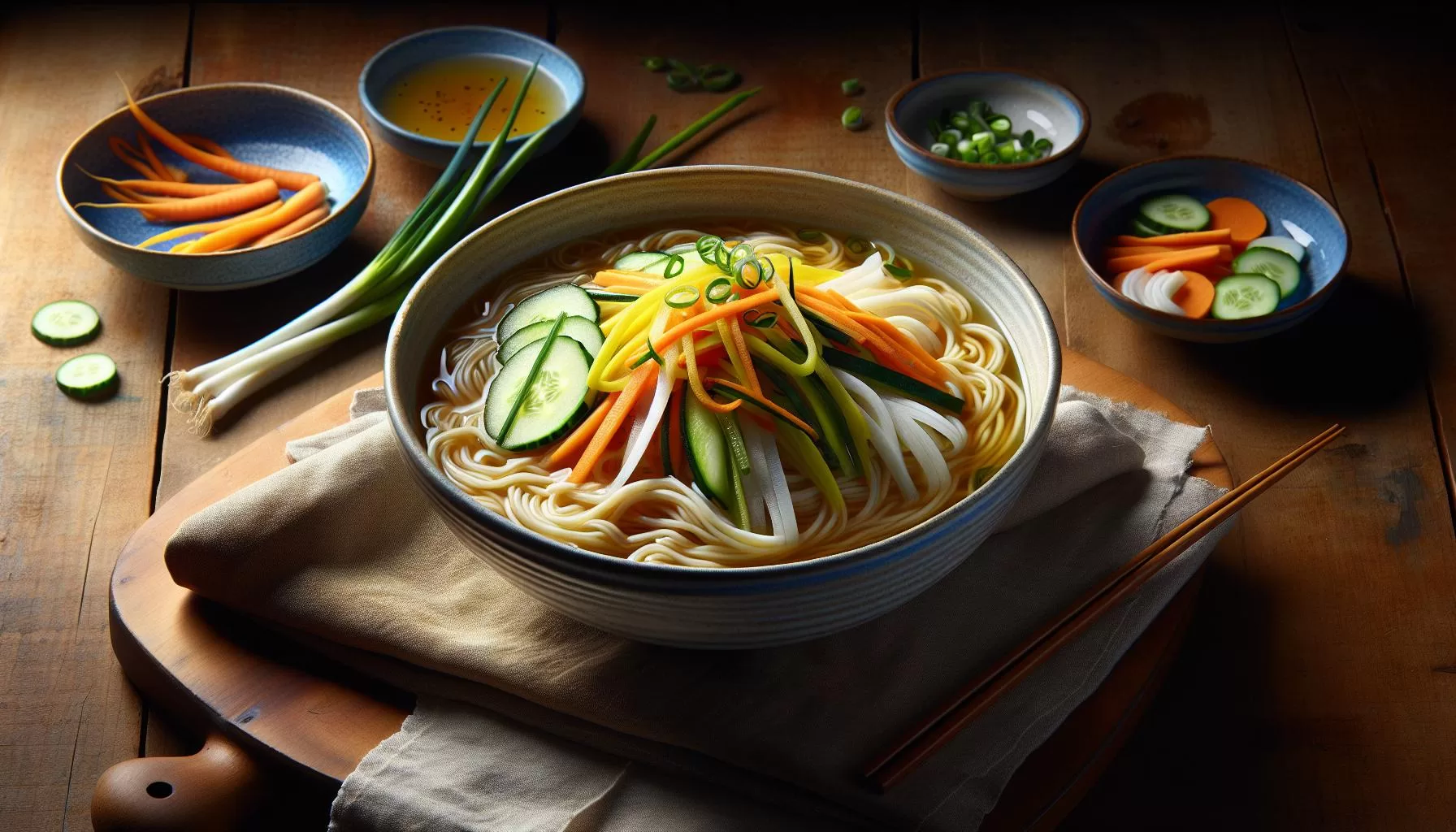Understanding Janchi Guksu Somyeon
Have you ever wondered about the core elements of Janchi Guksu Somyeon? The enchanting essence of this esteemed Korean cuisine is its delicate thin wheat noodles, expertly balanced broth, and vibrant toppings. You’re not just preparing a meal; you’re crafting a symphony of flavors and textures.
The name ‘Janchi Guksu’ itself translates to ‘banquet noodles’, underscoring its role at joyous events. It’s a hallmark of Korean feasts and celebrations. Take a deep dive into the recipe’s essential parts and you’ll unearth the cultural importance of each one.
Let’s emphasize the most crucial aspect, the noodles. Somyeon, thin wheat flour noodles, are the star of the show. They are similar to what you might find in Japanese ramen or soba dishes. Incredibly versatile, they carry the flavor of the dish while providing that satisfying chew.
Next, there’s the broth. It’s typically a light yet aromatic anchovy-based or beef bone-based concoction. It adds a delicate depth of flavor, highlighting the subtleties of the somyeon noodles.
Brimming with complexity and color, the toppings complete the dish. Varying based on personal preference and regional variations, a classic Janchi Guksu includes thinly sliced cucumber, scrambled egg strips, and seasoned seaweed. However, the beauty here lies in flexibility – feel free to create your own combination of toppings, adding your unique flair to this traditional dish.
Lastly, let’s touch on the seasoning. A mix of soy sauce, sesame oil, and brewed soy sauce infuses the Janchi Guksu Somyeon with a full-bodied savoriness. The right balance offers a hint of sweetness, a tang of salty and a tinge of umami – a taste that’s truly sublime to the senses.
Creating Janchi Guksu Somyeon at home isn’t just about mimicking a recipe; it’s a form of gastronomic storytelling. By understanding every part, you’re not only gaining culinary knowledge, you’re also appreciating the tradition and culture encapsulated in this remarkable dish.
Ingredients You’ll Need

For this homemade Janchi Guksu Somyeon recipe, you’ll need the freshest and highest-quality ingredients to hit that sweet spot of savory delight.
Noodles
First off, you’ll need Somyeon (thin Korean wheat noodles). Stick to about 200g, enough for two hearty servings. If Somyeon isn’t easy on hand, an excellent substitute is Japanese Somen noodles. Their thin, delicate nature closely mirrors Somyeon, allowing you to keep the dish’s traditional essence alive.
Broth
The next vital component in your arsenal is Anchovy Broth. Four cups would suffice. As this broth is the heart of the dish, it’s worth noting that it can be replaced with vegetable broth for a vegetarian variation. Remember, the broth plays a huge role in lending this dish its robust flavor profile.
Toppings
As for toppings, rendition is key. Longitude an array of bright, colorful veggies for a visually appealing and nutrition-full meal. Here are some recommendations:
- Korean Zucchini (1/2 cup, julienned)
- Carrots (1/2 cup, julienned)
- Egg (1 fried and julienned)
- Seaweed (one handful)
To enrich your toppings, you may add Fried tofu or Shiitake mushrooms. These can enhance both the nutritional value and the flavor.
Seasoning
Lastly, for seasoning, let’s not forget Salt (to taste) and Soy Sauce (1 tablespoon).
Special mention: It’s always a smart move to have Spring onions and Sesame seeds handy to garnish your dish, boosting its overall look and taste.
And there you have it, arm up with these ingredients, and you’re one step closer to crafting your homemade Janchi Guksu Somyeon. Now let’s move on to the cooking instructions. Are you ready?
Step-by-Step Cooking Instructions

For an unforgettable meal, it’s all about the process. Let’s dive into this exciting adventure and get started with your homemade Janchi Guksu Somyeon!
Step 1: Prepare the Broth
Start by cooking the base of your soup. Take two cups of fresh anchovy broth or vegetable broth if you prefer. Bring it to a simmer on medium heat. As it heats up, you’re building the first layer of flavor for your dish.
Little tip: Consider adding a piece of kelp to elevate your flavor profile.
Step 2: Cook the Noodles
Next up, your somyeon noodles. They’re the star of your dish so you want them perfect. For two servings, you’ll need about 200 grams. Cook them according to the package instructions. Make sure they are al dente. Drain and rinse them under cold water to stop the cooking process.
Step 3: Prepare the Toppings
While your noodles cook, let’s prep your toppings. Slice up one Korean zucchini, one medium carrot, and two shiitake mushrooms. Fry an egg and cut it into thin strips. Grab a handful of fried tofu and a strip of seaweed too.
Step 4: Season
Now back to your simmering broth. It’s time to season! A pinch of salt and a teaspoon of soy sauce should do the trick.
Step 5: Assemble
Lastly, let’s assemble your dish. Put your cooked noodles in a bowl. Add your broth and place the toppings on top. Garnish with spring onions and sprinkle sesame seeds for that final touch.
And there you have it! Your very own homemade Janchi Guksu Somyeon, ready to stir up your taste buds.
Tips and Tricks for Perfecting Your Dish

If it’s your first time making Homemade Janchi Guksu Somyeon, don’t fret. Here are a few top-notch tips and tricks to ensure your dish turns out just right.
A standout ingredient in this dish remains the somyeon noodles. Always check the cooking time suggested on the package. Generally, they’ll need 3 to 4 minutes in boiling water. But keep an eye out and regularly taste a strand to ensure you’ll achieve the perfect al dente texture. Nobody loves overcooked or mushy noodles!
While curating the colorful tonic of toppings, remember to chop veggies uniformly. It not only ensures even cooking but also presents an aesthetic appeal when served. Furthermore, when sauteing the Korean zucchini, carrots, and shiitake mushrooms, do it separately. It allows each one to maintain its distinct flavor.
We all know that flavoring holds the key in oriental cuisine. That’s where the soy sauce and salt play their roles in seasoning. Go easy on these, they can quickly overpower the entire symphony of flavors if you’re heavy-handed.
Keep track of your dish’s nutri-facts, especially if you’re health conscious or cooking for someone who is. For instance, a single serving of Janchi Guksu Somyeon might contain specific values of macronutrients. You could include a markdown menu table to underline these essential details.
Finally, be creative with your garnishing. Those spring onions and sesame seeds can be more than just a finish touch – try lightly toasting them for added oomph.
Serving and Enjoying Your Homemade Janchi Guksu Somyeon

Now that you’ve put in the hard work of preparing your dish, it’s time to enjoy the rewards. Janchi Guksu Somyeon is best served hot, right off the stove. Ladle generous helpings into bowls for each diner, ensuring a balanced mix of noodles, broth, and toppings in every serving. The key here is balance, don’t let one element overpower another. Take note, each mouthful should be a symphony of textures and flavors, working in perfect harmony.
One tip to further notch up your serving game is presentation. It’s not just about taste; the eye also eats. Experiment with colorful garnishes like sprinkled spring onions or toasted sesame seeds, and place them decoratively atop the dish. Don’t shy away from being creative.
Remember, sharing is caring. Janchi Guksu Somyeon is a communal dish, often served at gatherings and celebrations. Encourage diners to share their experiences, savoring the flavors, and embarking on an immersive journey into the heart of Korean cuisine.
Keeping track of the nutritional information is also crucial for health-conscious individuals. A typical serving of Janchi Guksu Somyeon can offer a balance of carbs, protein, and healthy fats. The addition of the vibrant veggies provides essential vitamins and minerals. To provide your readers a clearer picture, see the following table:
| Nutrient | Average Amount per Serving |
|---|---|
| Calories | 360 kcal |
| Carbs | 55 g |
| Protein | 12 g |
| Fats | 10 g |
| Vitamins | Various |
Lastly, like with any recipe, it’s wise to consider personal preferences. Some might prefer their noodles softer, others might favor a more potent broth. You can recommend taste testers to add a dash of soy sauce or a sprinkle of salt if needed. It’s all about making the dish their own. After all, cooking is an art, not an exact science. Each unique tweak is a reflection of a person’s individual tastes.
You know what happens when your art is appreciated? It ignites joy. That’s what cooking, especially dishes like Janchi Guksu Somyeon, does. It brings joy, not just to you, but to everyone it’s served.
Conclusion
So, you’ve ventured through the journey of creating your homemade Janchi Guksu Somyeon. You’ve learned not just about the cooking process, but the art of balancing flavors, textures, and even colors. You’ve discovered the joy of sharing this delightful dish and the value of personalizing it to cater to your taste buds. Plus, you’ve understood the importance of keeping track of nutritional content. Now, it’s time to take these insights and bring them to life in your kitchen. Remember, it’s not just about the dish, it’s about the experience. So, invite your loved ones, serve up your Janchi Guksu Somyeon, and enjoy the smiles it brings. After all, isn’t that the true essence of cooking?

